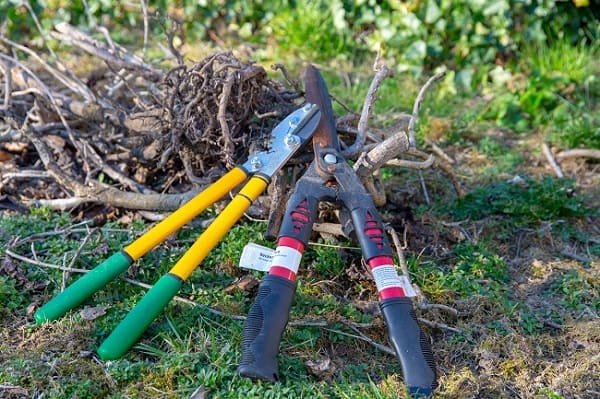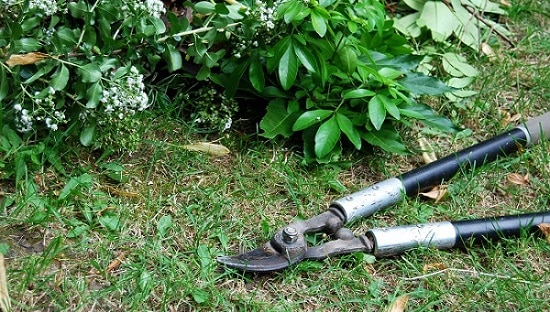
Keeping your landscape and yard looking tidy doesn’t have to be a tough task when you have the right tools. A hedge trimmer is one versatile tool that comes in different blade sizes to allow you to handle various gardening or landscaping tasks. You can use them to clear out weeds, shrubs, bushes, weeds, and overgrown grass.
A hedge trimmer can cut vines, although vines are more challenging and stronger to cut than hedges or grass. You may find it easy to cut vines from blackberry plants, but other types of vines are thick and you may need to use it with another tool.
Read on to learn how you can use a hedge trimmer to cut vines and some other tools that can help you cut thicker vines.
Using a Hedge Trimmer to Cut Vines
If you’re planning to cut vines with a hedge trimmer, you need to start from the external side of the clump vines. Work your way in slowly, ensuring that you tagged some inches at a time. Move the hedge trimmer in a sweeping motion from side to side to cut through the vines.
Remove the ones that you’ve already cut to ensure that they don’t get caught in the teeth of the trimmer. You may find that a few vines will move with the trimmer instead of being cut. That can be tedious, but you can use another tool to help you cut through the thick vines.
Tools to Cut Thick Vines
Some of the tools you can use to cut thick vines include:
Reciprocating Saw
If you have some tree species like tulip poplars, soft maples, or willows, you may need to prune them regularly. Having small vines no larger than an inch in diameter allows you to use a hedge trimmer.
However, if you have vines that are over two inches in diameter, you’ll need to get a reciprocating saw. The tool reduces the effort needed to cut the vines and speeds up the work. You’ll find that the cordless reciprocating saw enhances safety, especially when cutting wood.
Another advantage is that a reciprocating saw doesn’t kickback. Kickbacks can be dangerous and may cause severe injuries. When using this type of saw, ensure that you have safety gear on, including eye protection.
Hedge Shears

Hedge shears have the widest variety in use, handle, and blades. The shears have blades that are 7-9 inches long and handles that are up to 15 inches long. When dealing with vines, grab a pair of hedge shears and get the job done. You can cut vines that are 2 1/4 inch or less in diameter.
However, note that you can only use shears on tender new vines. If you are targeting hard and old stacks, you’ll need to get loopers or pruners.
When choosing hedge shears, ensure you get one with durable rubber stops and comfortable grips to reduce the effect of blades clumping together,
Hand Pruners
Also referred to as clippers, hand pruners are maneuverable and light, unlike shears or loopers. You can use them to make precision snips or cut out unwanted vines. The best part is that hand pruners can reach places other big tools like hedge trimmers can’t.
Bypass pruners are fantastic for growing, green vines. They use a scissoring action to cut through the vines as it passes the base. Anvil hand pruners work best for dry vines and stems. They use a splitting action to cut across the vine.
Pruning Shears
Sharp pruning shears are ideal for cutting through thick vines. The best part about using pruning shears is that the tool leaves a smooth and clean surface devoid of any loose fibers. That ensures that the vines don’t dry out below the cut surface and that the nearby sap flow won’t be damaged.
Remember that vines need to be treated like shrubs. Vines grown for their foliage produce a lot of growth and you may need to prune them often. Pruning shears can help you achieve these results.
For example, when dealing with pumpkin vines, you need a sharp pruning shear to cut secondary vines that grow from the main vine. Remove the tertiary vines from the secondary ones as they develop. Cut next to the intersecting secondary bones with the shears. You’ll also need to cut the main vine as it grows to ensure that all the energy is directed into growing the fruit rather than vine growth.
Note that pruning shears can be used in combination with a hedge trimmer as they are used for vines with diameters of up to 3/4 inch thick.
Some pruning shears manufacturers have come up with innovative vine pruning shears on the market. These shears are lightweight, easy to use, and have the right ergonomics to adapt to your pruning habits. Find shears with cushion grips and rubber stops as they lessen the shock of thick cutting.
Loppers

Sometimes removing the healthy growth of most plants stimulates their growth, which results in more flowering and vegetation. If you have lots of woody vegetation around your property, loppers are a must-have.
Loppers can help you cut through some vines like trumpet vines, climatic, and more without much difficulty. These trimmers are designed to handle large diameters. Most of them cut up to two-inch in diameter. However, the loppers come labeled with the size they can handle.
Bypass loppers have a design like that of scissors, where two blades cross each other to complete the cut. These loppers create a clean-cut, thus less stress on the plant. You can also cut close to the existing vine without leaving a nub.
Anvil loopers transfer the user’s power into the cutting force. On this lopper, the anvil brings one blade to the other, exerting a force between the surfaces to cut the vines. These loopers work well for cutting up vines and for trimming off large areas of dead vines.
Pruning Saws
If you’re familiar and comfortable with saws, you can opt for the pruning saw to cut vines. A pruning saw provides a clean-cut, unlike a bow saw.
The pruning saw handles 1 1/2 inch thick branch, making it perfect for larger-diameter vines. Its blade is the most essential component of a pruning saw. Blades like the three-angled, trim-edge, turbo, or Japanese are perfect for a clean cut.
Each tooth on these blades has three levels, which means that you get smooth and fast cutting. When using a pruning saw, find one that is light and compact to carry through the yard for the best cuts on trees and shrubs.
Pole Pruners
Pole pruners are ideal for light vine cutting and they can handle up to 1 1/4 inches of vines. The best thing about these pruners is that they can reach at least eight feet or higher, meaning you don’t have to use a ladder to get to the vines that are up the walls or trees. You can opt for the manual or the electric pole pruner.
Summary
Hedge trimmers are a fantastic tool to have in your gardening or landscaping work. You can use them for solitary shrubs and trimming hedges. These trimmers can also help cut small and thin vines. However, if you’re planning on handling large vines, you may need to consider using loppers or hand shears. You can also use the reciprocating saw in combination with the hedge trimmer to achieve a clean cut.

